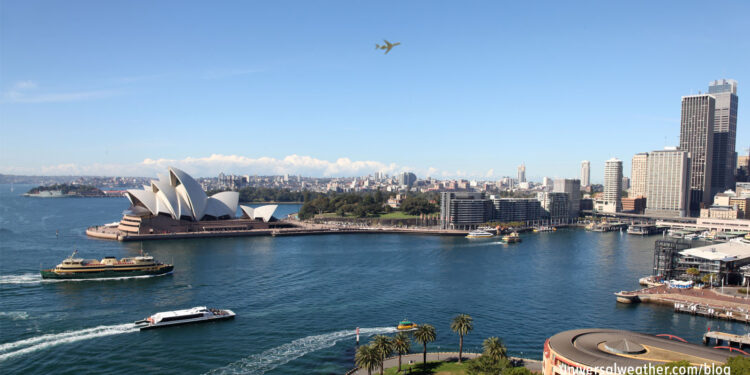Business Aircraft Ops to Australia: Part 1 – Top Airport Options

This is a post by author Tony King. Tony is the managing director at Universal Aviation Australia. Tony is an expert on business aircraft operations in Australia and can be contacted at tonyking@universalaviation.aero.
This is part one of a two-article series on business aircraft operations to Australia.
With the peak travel season in Australia now underway, it’s a good time for us to review planning considerations for business aircraft operations to our country. Traveling to Australia is a straightforward process without an excessive number of restrictions or lead time requirements. There are, however, considerations to be mindful of – depending on your type of flight and destination.
The following is an overview of what you need to know:
1. Peak season is summer
Summer time (winter in the Northern hemisphere) is peak travel season for Australia – particularly the northern region. For Brisbane, Sydney, and Perth, peak travel period is October through March, while Melbourne has a slightly shorter peak travel period as it’s farther to the south. The majority of General Aviation (GA) flights to Australia are for business rather than tourism purposes. In general, GA traffic to Australia is steady throughout the year.
2. There are five top peak-season destinations
Top destinations for GA are Sydney, Melbourne, Brisbane, Cairns, and Perth. In many cases international flights arrive at Sydney (YSSY) and continue on to other cities. Business and tourism draws for Australia include the annual Australian Open tennis tournament and Formula One Grand Prix auto races, horse races in Melbourne, and the Great Barrier Reef area close to Cairns. Ayers Rock, a large sandstone rock formation 208 miles SW from Alice Springs (YBAS), also draws international visitors to the continent.
3. Sydney requires airport slots
Be mindful of airport slot requirements and operating curfews when operating to YSSY. Maximum Takeoff Weight (MTOW) limitations are currently in place for this location for the night curfews. Between 2300 and 0600 local, incoming flights are limited to an MTOW of 74,957 lbs. (34,000 kg) at the last point of departure. Likewise, aircraft will not be permitted to depart YSSY during the curfew if the aircraft weighs more than 74,957 lbs. (34,000 kg). Customs, Immigration, and Quarantine (CIQ) clearance for YSSY normally takes place within the main terminal, but it’s possible to clear within the Fixed-Base Operator (FBO) with prior arrangement. Approval for an FBO clearance, however, is at the discretion of local customs/immigration authorities.
4. Melbourne has two airports
Melbourne Intl (YMML) is the primary international airport for Melbourne, and this location typically has more operational delay potential than Melbourne Essendon (YMEN). While YMEN has FBO facilities available, YMML does not. YMEN is often the primary choice for domestic legs within Australia, and CIQ clearance for international flights can be arranged, but at the discretion of local customs and immigration authorities. Note that runway length is 6,302 feet at YMEN versus 11,998 feet at YMML. GA parking is usually less expensive at YMEN, but there’s a 99,208-lb. (45,000-kg) MTOW limitation for operations to this airfield. It’s also important to keep in mind that YMEN has an operating curfew in place between 2300 and 0600 local, and no exceptions to this are possible.
5. Brisbane also requires airport slots
Brisbane (YBBN) requires airport slots for all arrivals/departures. Operational delays, from time to time, are experienced at this location, but are not excessive. GA parking can be an issue at YBBN as ramp space is limited. A second runway is currently under construction at YBBN, but completion of this is still a few years out.
6. Cairns may have delays from time to time
As aircraft parking at Cairns (YBCS) can be an issue, from time to time, it’s best to confirm parking availability in advance. At times you’ll be parked in a remote area, and travel to/from the CIQ clearance area can be some distance. Your ground handler will arrange for local, on-airport, transport.
7. Perth CIQ night clearance may not be possible
Airport slots are needed for all operations to/from Perth (YPPH). Note that CIQ clearance during evenings may or may not be possible to arrange. It’s important to have your ground handler confirm all CIQ clearance arrangements at YPPH in advance. If you’re not able to confirm CIQ services for your planned time of arrival, you’ll need to either consider changing schedule or arriving/departing the country via another airport where CIQ is available.
8. Full services are possible
Full aircraft support services are available for private non-revenue and charter (non-scheduled commercial) operations to Australia. Credit for all services and airport charges can be set up at major airport locations with prior arrangement. While infrastructure is in place to handle all types of GA aircraft, it’s important to keep in mind that YMEN enforces a 99,208-lb. (45,000-kg) MTOW limitation for all aircraft. This policy is non-negotiable.
Conclusion
Particularly when operating during high season to airports with large local events underway, it’s important to begin the trip planning process as soon as the schedule is known. CIQ procedures and considerations may differ from airport to airport. Depending on your destination and the time of arrival, parking availability and MTOW limitations could be factors to consider.
Questions?
If you have any questions about this article or would like assistance planning your next trip to Australia, contact me at christinevamvakas@universalaviation.aero.
Later, we’ll discuss general operating considerations for travel to Australia.




